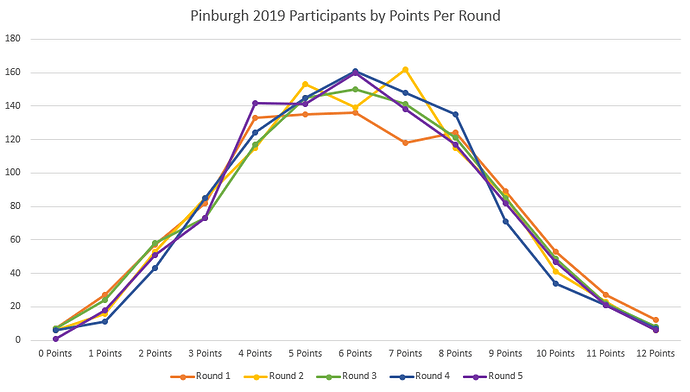Fort Wayne, Indiana would now qualify with a 21 point minimum for winning an event. The entire state is rapidly growing from a competitive standpoint.
Why not hide the results of standings on day 1 so that it makes sandbagging a guessing game?
results are identical from 2018 to 2019
A cut line 2018: 35-25 2019: 35-25
B cut line 2018: 32-28 2019: 32-28
C 2018: 29-31 2019: 29-31
D 2018: 26-34 2019: 26-34
Interesting that it’s so consistent. I wonder how it’s changed over the years.
someone can probably explain the statistics behind it, but it’s pretty close to the same since 2015 (if you break 2017 and earlier into 5 divisions).
The only differences are: 2015 A would have been cut at 34.5, D would have been 25
2016, A would have been 34, D would have been 25
2017, B would have been 31, D would have been 25
Not a statistics expert, but my understanding is that the Swiss pairing (or in this case, the Tiered Swiss pairing) more or less forces people of similar skill to play each other as you go further into the rounds, which results in a nice normal-ish distributed bell curve regardless of the number of people who are in the tournament. It doesn’t matter how many people are in the tournament as we would see a similar convergence to the same curve.
@haugstrup has a nice visualization of a tiered swiss event here: http://seeder.slapsave.com/?player_count=128&rounds=10. Not the exact same as Pinburgh (which has some nuance to three-player groups for high seeds and how later rounds are dealt with).
I don’t think a Tiered Swiss simulator exists, but I found a regular Swiss simulator to try to mimic what happens across Day 1. Essentially, you have 20 games played which results in 60 “head-to-head” results, so you effectively have 60 decision points that results in a win or a loss.
http://swisstriangle.net/ -> 1000 Players, Force Round Count to 60
Results:
1 players at 60-0
1 players at 41-19
4 players at 40-20
7 players at 39-21
12 players at 38-22
21 players at 37-23
31 players at 36-24
46 players at 35-25
60 players at 34-26
76 players at 33-27
90 players at 32-28
99 players at 31-29
104 players at 30-30
99 players at 29-31
90 players at 28-32
76 players at 27-33
60 players at 26-34
46 players at 25-35
31 players at 24-36
21 players at 23-37
12 players at 22-38
7 players at 21-39
4 players at 20-40
1 players at 19-41
1 players at 0-60
Cutoffs:
A - 33
B - 31
C - 29
D - 27
This simulated curve is a bit tighter because it pushes you down the bracket immediately after each result, which is a bit different than Pinburgh since we have four-game rounds with the same opponents before moving on in the Swiss Pairings. I would presume each of the five initial rounds has it’s own normalized distribution of 0 to 12 points within the round, but I haven’t had the opportunity to extract round-by-round data and plot it yet. It’s a series of distributions resulting in a super distribution, which should result in very similar Round 5 numbers each year regardless of number of participants.
Made a very quick graph of the distribution of points for Rounds 1-5.
Edit: Updated with correct Round 3 data.
| Points | Round 1 | Round 2 | Round 3 | Round 4 | Round 5 |
|---|---|---|---|---|---|
| 0 Points | 7 | 6 | 7 | 6 | 1 |
| 1 Points | 27 | 16 | 24 | 11 | 18 |
| 2 Points | 57 | 53 | 58 | 43 | 51 |
| 3 Points | 82 | 85 | 73 | 85 | 73 |
| 4 Points | 133 | 115 | 117 | 124 | 142 |
| 5 Points | 135 | 153 | 145 | 145 | 141 |
| 6 Points | 136 | 139 | 150 | 161 | 160 |
| 7 Points | 118 | 162 | 141 | 148 | 138 |
| 8 Points | 124 | 115 | 121 | 135 | 117 |
| 9 Points | 89 | 86 | 85 | 71 | 82 |
| 10 Points | 53 | 41 | 49 | 34 | 47 |
| 11 Points | 27 | 23 | 22 | 21 | 21 |
| 12 Points | 12 | 6 | 8 | 7 | 6 |
cool stuff though round 2 and 3 have the exact same results? is that true or a duplicate?
Ohh, good catch. I updated the original post with the correct numbers.
That’s a great visualisation. You can see how there is some randomness in the earlier rounds, but as the groupings get tighter in later rounds, the bell curve is more perfectly formed
Great info! Shows what you would expect with more 12’s in round one than any other.
Is this the first year for these Satellite tournaments?
How does one signup to host one of these?
This is the first year we have run these. For this year I hand selected some TDs around the United States to run these. If this year goes well, we will consider expanding them and possibly opening it up for people to apply to host them.
Please mark me down for next year.
I think the dates are a year off
If these go well this year, there will most likely be some type of application process to host one next year.
HA! They’re right on the graphic on social media. We’ll get this fixed. 
So Feb 22 at 12pm eastern is when tickets go on sale?
Omni and Westin blocks have been released:
https://replayfx.org/travel/
